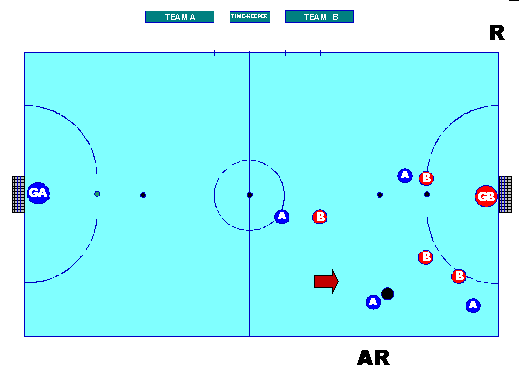
FUTSAL
REFEREE MECHANICS
CO-
OPERATION AND POSITIONING BETWEEN THE REFEREES
Given the fact that FUTSAL
has two (2) referees empowered to enforce the Laws of the Game, it is imperative
that the referees establish a system of control to enforce the Laws of the Game.
The system of control must be flexible yet rigid enough to clearly define
each referee’s position and responsibility throughout the match.
The result of good positioning will be a system of control that enables
cooperation and communication.
Laws V and VI provide instruction as to the powers and duties of the Referee and the Assistant Referee. Prior to the game, the Referee shall communicate and review the system of control with the Assistant Referee and the Timekeeper. Proper positioning, constant visual contact, and hand signals by the referees will assist understanding through clear communication.
The following summarizes the
positioning and mechanics to be utilized by the referees during a FUTSAL match.
With two (2) referees
controlling the match, there will always be a “Trail Referee” (TR) and a
“Lead Referee” (LR). The Lead
Referee is always in front of the ball on the attacking half of the field
leading the attack. The Trail
Referee is always behind and trailing the ball as it moves to the opposite goal.
The referees’ position as trail or lead changes as teams exchange
possession of the ball. Referees
should not take stagnate positions. Referees
must always be moving and running. Referees patrol the entire touch-line on their side of the
playing court. As a result, the
referee will need to move along the touch-line to monitor positions for
kick-ins, corner kicks, fouls, and other restarts as permitted by the Laws of
the Game. The referee’s position
is flexible as the guidelines provided herein are followed.
Regardless of the location of
an infraction or foul on the pitch, the Laws of the Game require action by the
referees. Hence, it does not matter
which referee takes the appropriate action whether it be signaling for a foul or
dealing with misconduct. Prior to
making a decision, referees should have visual contact with their partner and
consider the following, in particular if the foul or misconduct occurred closer
to their partner than them:
1.
Did my partner see it?
2.
Was my partner in position to see it?
3.
What impact will my failure to take action have on the game?
Regardless of which referee
has signaled a foul, the referee on whose side the infraction occurred shall
move quickly to the spot of the foul to monitor the restart and protect against
encroachment. See Diagram 1.
The other referee shall take a position as the Lead or Trail Referee
depending upon the proximity of the foul to the goal.
For indirect free kicks, both referees shall raise their arms to indicate
the fact that the kick is indirect.

Diagram # 1